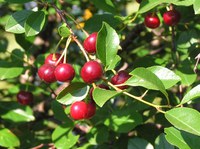Dakota Gardener: The Best Backyard Fruit Tree
(Click an image below to view a high-resolution image that can be downloaded)
By Tom Kalb, Horticulturist
NDSU Extension
Fruit trees are great for landscapes. Their blossoms are dazzling in spring and the fruits are absolutely delicious.
Do you have a fruit tree in your backyard? If not, what are you waiting for?
When it comes to planting trees, there is an old proverb that goes, “Today is the second-best day to plant a tree. The best day was yesterday!”
Don’t keep waiting. Fruit trees take years before they begin to bear fruit.
What’s the best fruit tree for a backyard?
I highly recommend the Evans Bali sour cherry. It has so many great qualities!
First, the tree is small and can fit easily into a landscape. The tree gets no more than 15 feet high and 12 feet across.
Another nice feature is it will pollinate itself. You don’t need to plant two different cherry trees for fruit production. One is enough. Nearly all other hardy fruits including apples, pears and American plums require two varieties of trees for fruit production.
A cherry tree looks beautiful all year. In spring, the tree is covered with clusters of bright-white flowers. The foliage is rich-green in summer, turning orange in fall. The bark is reddish brown and glossy, making it a handsome plant in the winter.
Evans Bali is a tough tree that withstands tough conditions. It was discovered in Alberta and can tolerate our harshest winters. This tree grows well in our soils and can withstand urban conditions and pollution.
Evans Bali is easy to care for. I never spray my tree. In March, I give it a light pruning to open the canopy to more sunlight and air movement. Evans Bali produces very few suckers, which is another reason why I love it.
Best of all, the Evans Bali cherry is famous for its precocity and high yields. You will be picking buckets of cherries after only three to four years. This is in stark contrast with apples and pears where you may wait six years or longer before you get any meaningful harvests.
Although Evans Bali is a sour cherry, its fruits are among the sweetest of all sour cherries. The fruits are perfect for making pies, jams and jellies. No sweet cherries are hardy in North Dakota.
The only significant pest problem of cherries is spotted wing drosophila. This fruit fly has not found my tree yet. If it ever arrives, I can spray the tree a couple times with spinosad or another safe insecticide to kill the pests.
The major challenge with growing cherries will be the birds. Birds love cherries. You can put a net over your tree to protect your crop.
I take a simpler approach and share my crop with the birds. When I see the birds invading my tree, it indicates the fruits are becoming ripe. When the fruits are ripe enough, I scare the birds away for an hour and harvest the bulk of the crop. The birds can enjoy the rest.
Pitting the fruits can be time consuming. I’ve recently heard great comments about Leifheit cherry pitters. I’m going to invest in one this year. They pit the fruits quickly and easily.
If you prefer to add a shrub instead of a tree to your landscape, consider the dwarf cherry shrubs from the University of Saskatchewan. Two varieties are most noteworthy. Carmine Jewel will produce abundantly and reliably year after year. Romeo has sweeter fruits and ripens earlier, making it less subject to the fruit flies.
I encourage you to add a cherry tree or shrub to your landscape this spring. Enjoy the beauty of the plants and get ready for some delicious cherry pies and cobblers.
For more information about gardening, contact your local NDSU Extension agent. Find the Extension office for your county at https://www.ndsu.edu/agriculture/extension/county-extension-offices.
NDSU Agriculture Communication - May 10, 2022
Source: Tom Kalb, 701-328-9722, tom.kalb@ndsu.edu
Editor: Kelli Anderson, 701-231-6136, kelli.c.anderson@ndsu.edu




